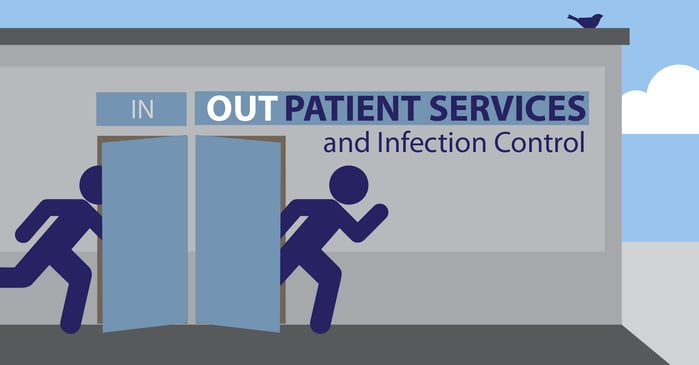Outpatient Services and Infection Prevention: What is Ambulatory Care? [Part 2]
![Outpatient Services and Infection Prevention: What is Ambulatory Care? [Part 2]](https://blog.eoscu.com/hs-fs/hubfs/Small_Blog_Headers/Outpatient_Services-01.jpg?width=950&name=Outpatient_Services-01.jpg)
 Any kind of medical treatment received outside of a hospital admission is considered ambulatory care, or outpatient care. This category of healthcare is growing very quickly; in fact, it is the fastest growing health care market in the US! Outpatient services are growing in popularity for two main reasons. First, they are less expensive than hospitals, which have much higher overhead costs. The second reason is that medical improvements have made outpatient services far more practical. The quality of home health care through technology and nursing services allow patients who would have had to be in a hospital receive the necessary care at home.
Any kind of medical treatment received outside of a hospital admission is considered ambulatory care, or outpatient care. This category of healthcare is growing very quickly; in fact, it is the fastest growing health care market in the US! Outpatient services are growing in popularity for two main reasons. First, they are less expensive than hospitals, which have much higher overhead costs. The second reason is that medical improvements have made outpatient services far more practical. The quality of home health care through technology and nursing services allow patients who would have had to be in a hospital receive the necessary care at home.
Up to 75% of surgical procedures in the US take place in the more than 5,000 outpatient surgical centers. (There was a 300% increase between 1996 and 2006, the last time a survey was made. More on that in our next post.) Add to this the number of scans, tests, dialysis sessions, chemotherapy treatments, and other procedures and you begin to see the vast numbers of individuals receiving medical care at ambulatory care facilities. As more and more of us choose these outpatient services for increasingly complex procedures, it is all the more important to learn about this critical area of health care.
Ambulatory care, or outpatient services, can be divided into three main categories.
Diagnostic
Many ambulatory care centers focus on helping diagnose a medical issue. These include radiology and imaging centers where patients can be scanned using the same cutting-edge technology found in a hospital, without having to deal with the complications of a hospital visit. In a hospital, for example, an outpatient appointment could be postponed if an inpatient emergency required use of the equipment. Patients can instead go to one of these free-standing facilities to receive an X-ray, a CT scan, an MRI, cardiac stress test, echocardiogram or laboratory test.
Short-Term Treatment
Some patients needing treatment can use ambulatory care instead of checking in as an inpatient at a hospital. Urgent care centers provide off-hours or immediate treatment when an emergency room visit is not necessary. Outpatient surgery centers (including cosmetic surgery centers) provide a more affordable and convenient way to get many standard procedures. Some of the most common outpatient surgeries are cataract surgery, hernia repair, ear tube surgery, lumpectomy, and tonsillectomy. Patients of all ages use ambulatory surgery centers, but they all have one thing in common: Overall, patients who are recommended for ambulatory care are typically healthy individuals without underlying conditions that could result in complications. (A hospital would be far better prepared to deal with complications than an ambulatory surgery center.) Follow-up care for outpatient surgeries is provided by the patient’s primary care physician, or, in some cases, by the surgeon at his or her private practice.
Long-Term Treatment
While no one remains in an outpatient facility overnight, long-term treatment can be provided. This treatment category refers to short treatments given repeatedly over long spans of time and includes physical therapy, renal dialysis, cancer treatments (radiation and chemotherapy), as well as treatments for chronic diseases. Being able to receive these treatments in an outpatient setting is not only more affordable for patients, it also allows patients to maintain their regular lifestyle and schedule more easily. Patients may receive treatment over a few visits, or many spread over several years.
Our next post will explore how infection prevention is handled at each of these types of ambulatory care settings, and some of the more troubling outbreaks that have occurred due to lapses in infection control. You may be surprised to learn just how little is known about infection and ambulatory care.
Read the Full Series
|
|
| Part 1: What are Outpatient Services? | Part 4: Tracking Infections |
| Part 2: What is Ambulatory Care? | Part 5: Room for Improvement |
| Part 3: Outbreaks & Reporting | |
Editor's Note: This post was originally published in March 2016 and has been updated for freshness, accuracy and comprehensiveness.
![EOScu Logo - Dark - Outlined [07182023]-01](https://blog.eoscu.com/hubfs/Eoscu_June2024/Images/EOScu%20Logo%20-%20Dark%20-%20Outlined%20%5B07182023%5D-01.svg)

![Outpatient Services and Infection Prevention: An Introduction [Part 1]](https://blog.eoscu.com/hs-fs/hubfs/Small_Blog_Headers/Outpatient_Services-01.jpg?height=500&name=Outpatient_Services-01.jpg)
